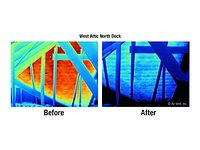
One of several streets that make up Dong Xa
village. There is a large group of rice fields behind the homes on the left.
Perhaps the most important role the roofing industry plays is its part in bringing shelter to the masses. We call it “The American Dream” - the dream of owning a home. Though somewhat challenged by the global recession, the dream has not dimmed.
While the opportunity for the majority of its population to own a home seems a uniquely American phenomenon, I have seen time and time again that the dream is international. Everyone on this planet desires a decent place to call home. Together with a few hundred of my closest friends from the United States and New Zealand, I recently had the opportunity to see the dream come true for 32 families. We traveled to Dong Xa, a village of KeSat, roughly 40 miles from Hanoi, Vietnam. We went as volunteers with Habitat for Humanity International (HFHI) for the 2009 Jimmy and Rosalynn Carter Work Project – The Mekong Build.

The village children at play.
Founded in 1976 by Linda and Millard Fuller, HFHI was organized with the goal of eliminating substandard housing from the planet. To achieve this goal, Habitat raises funds and builds homes in partnership with hardworking families who must put money and “sweat equity” down in order to qualify to pay full price for a simple, decent home. Habitat finances the home with a no-interest loan. Qualifying to become a Habitat homeowner is a complex process, but the basic requirements include a qualified need - that is, coming out of substandard housing and the inability to finance a home on the open market. The homeowner must also demonstrate the ability to make the mortgage payments. Habitat in turn uses the mortgage payments to fund operations and build more homes.

House Leader Mark Butler prepares to hang gutter
on House No. 12. (Photo courtesy of Mark and Lael Butler.)
The 2009 version of the project was called The Mekong Build, as it was conducted in five countries that border on the Mekong River: China, Cambodia, Laos, Thailand and Vietnam. The main site for the build was in Thailand, which is where Jimmy and Rosalynn Carter worked to build a home. Yes, they show up to work each year in addition to attending all of the press conferences and photo ops.

Pham Von Chung and Rick
Damato at the end of the week.
Habitat always builds with local affiliates, and the construction follows local code and tradition. The Vietnam portion of The Mekong Build was conducted under the auspices of Habitat for Humanity Vietnam (HFHV). HFHV was established in 2001 and specializes in the implementation of sustainable community-based shelter, water and sanitation.
The build in Dong Xa was no exception as the homes built, while small, were constructed with block covered with a stucco-like surface called “rendering” and topped with an insulated metal roof. As for water and sanitation, each home received a 42-meter-deep well with an electric pump and holding tank. Each home was equipped with a very basic septic system to handle the waste. Not a complete sanitary solution, but by developing world standards it is far better than most.
The 32 homes built in Dong Xa are all 4 meters by 9.2 meters, or just over 396 square feet. Owing to the time when the French were in charge, many homes and buildings in Vietnam are 4 meters wide. It seems that the tax rate jumps geometrically when the structure exceeds four meters of road frontage. The homes had a double-front entry and a single in the rear. There were windows, one each, in the front room and in the food preparation area. Each home had a separate room for a toilet and shower and several light fixtures and outlets.

Former president Jimmy Carter addresses the
volunteers and homeowners. His wife Rosalynn is on the left.
In addition to building 32 homes in the village HFHV made significant improvements to the community center, the sewer system, and even provided landscaping along the main road leading into the heart of the village adjacent to the village cemetery. Construction of the homes also improved the overall appearance of the village by filling in lots that previously stood empty.
The village consists of several gravel roads and is situated between a river and a series of rice fields. The rice fields and river provide work to many who live in the village. In fact, many of the new Habitat homeowners were able to move their families off the fishing boats to a place on land. The people of the village were glad to have us as their guests for a week. The language barrier was fairly significant, except for the children. They speak the universal languages of smiles, laughter, and play.

House No. 8 with the front wall complete.
While we were in Vietnam as a group, we were divided up into smaller groups as we worked, for the most part, to complete construction of the same home all week long. In my case it was House No. 8 and homeowner Mr. Pham Van Chung. Chung worked side-by-side with the volunteers all week long. He mainly kept the mortar flowing in the beginning and transitioned somewhat to quality control technician as we entered the finish stages.
We could not speak directly to each other except for our exchange of greetings with him saying, “Hello!” and me returning with “Xin chao!” We managed to get by quite nicely with a series of hand gestures. On Wednesday morning Chung invited me to the nearby home of his daughter for tea. He took a great deal of pride serving a tea that was very popular in Vietnam. Strong, but I really liked it. The next day we managed to get a good translator and I was able to get some of Chung’s history. It turns out we are both the same age. We’re both fathers and both grandfathers. The similarities end there. Chung sold his rice fields in order to buy land to build homes for his children and grandchildren. This former rice farmer now makes a living selling candy from a storefront that is the front room in his daughter’s home where he served me tea.

Rick
Damato sends out a message of thanks to the Masonry
Association of Georgia.
It would be improper for me to leave out the other partners on House No. 8, including the sponsor, Exxon/Mobile Vietnam. Not only did they sponsor, but their senior executive, Russ, and his staff joined in with laying block, hanging windows, and whatever it took.

House leaders receive instructions on roof
installation.
Jimmy and Rosalynn Carter spent most of the week working on a home in Thailand but did pay a visit to Vietnam to meet with sponsors, volunteers, and homeowners. President Carter gave a brief but compelling address to the volunteers, homeowners and several officials of the Vietnamese government. It seems this was Carter’s first trip to Vietnam. He recalled that their oldest son dropped out of Georgia Tech to join the armed forces to serve here. He was not rude, but did not sugarcoat his message of continuing concerns for human rights in this country.
This project took place in the former North Vietnam. Several of the U.S. volunteers were returning to this part of the world for the first time since the late 1960s and early 1970s. Some veterans of the War in Vietnam made this trip for healing in addition to the work. One U.S. veteran sat hand-in-hand with another volunteer during Carter’s address. The other volunteer was from Hanoi and had served as a gunnery sergeant with the Viet Cong during the conflict.

The team from House No. 8 poses with the
Carters. (Photo courtesy of Habitat for Humanity International.)
This project was led by Vietnamese construction engineer, Tich Tran and an American couple, Vic and Lora Fasolino. Tich provided the design and technical support. Vic served as the lead on construction and Lora handled supply logistics in addition to her duty of keeping Vic straight.
The project was substantially but not fully completed during the build week. All goals for construction were met and the project was set for completion within another week or so by remaining volunteers and professionals. During the week there were zero serious injuries. We were blessed by cool weather, unlike the build in Thailand, where temperatures hit 100 degrees during the day.

Chung treated House No. 8 volunteers to a
traditional Vietnamese tea ceremony with members of his family.
For me, it is many things, including the opportunity to meet people from other cultures. It was indeed an honor to have met Chung and have tea in his home. It was an honor to meet his wife and his children and grandchildren. I did not make a real difference in their lives; their sacrifices and hard work earned them a new home. They, on the other hand, made an indelible mark on mine. And if there was one memory that will make me seek this work again, it was the gentleman homeowner who wept as he shook the hands and thanked every single volunteer as we boarded buses on the last day of the build. And all I could say was, “Goodbye Vietnam!”



